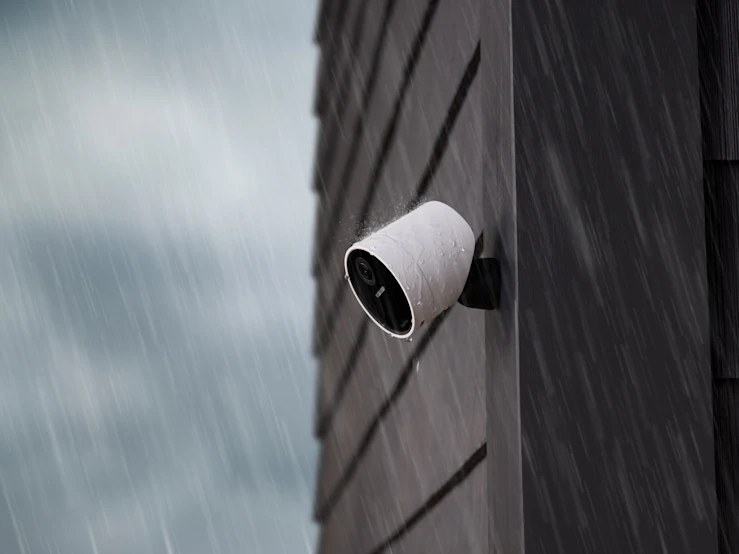How To Protect Your Home During a Summer Storm
Posted June 24th, 2024 by SimpliSafe

Summer brings warm weather, but depending on where you live, thunderstorms may come with it. While these storms can be fun to watch (from the safety of your home), thunderstorms can pose risks to your safety and property.
The good news is that there are steps you can take and certain equipment you can invest in to keep the damage from thunderstorms at bay. Read on to find out how you can keep your home and family safe during storm seasons.
What Can a Thunderstorm Do to Your Home?
Before a storm even hits, it’s important to understand how it can potentially impact your home:
Lightning strikes: Lightning poses a significant danger during thunderstorms. A direct lightning strike on your home can cause fires, damage electrical systems, and even lead to structural damage. A lightning strike can also cause trees to weaken and fall.
Strong winds: Thunderstorms often bring strong winds that can cause damage to roofs, siding, windows, and doors. Wind can also cause trees or branches to potentially fall on your home, causing additional damage.
Heavy rain and flooding: Thunderstorms can bring heavy rainfall, which may result in flooding if the drainage system around your home is inadequate. Floodwaters can damage the foundation, walls, and floors of your home.
Storm surges: Speaking of floods, if you live in coastal areas, severe thunderstorms can sometimes bring storm surges, which are elevated water levels that can flood coastal properties, causing significant damage.
Power outages: Lightning strikes and strong winds can disrupt power lines, leading to power outages that might last for hours or even days.
Safety Tips for a Thunderstorm
During a thunderstorm, your safety and the safety of your family should be the top priority. Follow these basic safety tips to minimize risks and take time to review them with younger children.
Stay indoors: Avoid going outside during a thunderstorm. Seek shelter in a sturdy building or a hard-topped vehicle.
Avoid electrical appliances: Refrain from using wired electronics, as lightning can cause power surges that might damage devices and cause possible electrocution.
Avoid water: Don't take a bath or shower during a thunderstorm, as plumbing fixtures can conduct electricity.
Stay away from windows: Keep away from windows to avoid potential shattered glass due to high winds or lightning strikes.
Avoid trees and metal objects: Tall trees and metal objects can attract lightning. Stay away from them to reduce the risk of being struck.
Preparing for a Thunderstorm
Before a thunderstorm strikes, it's essential to prepare. First and foremost, you’ll want to make sure your family is safe from the immediate threat of a storm, which means getting inside as soon as possible. Even though a home can be physically impacted by a thunderstorm, you’re still much safer inside than out. Once everyone — including pets — is inside, it’s time to prepare your home for any potential storm impact.
Secure outdoor objects: Strong winds accompanying thunderstorms can turn loose objects into dangerous projectiles that can potentially hit a window and hurt someone inside. If there’s time before the thunderstorm really starts brewing, secure or bring inside any outdoor furniture, toys, and garden equipment.
Secure electrical equipment: In order to secure your electrical equipment, an adult should unplug sensitive electrical devices and appliances to prevent damage from power surges during lightning strikes. Consider using surge protectors for added protection. With this in mind, you’ll want to make sure you have your phone fully charged before a thunderstorm hits or have a backup charger or battery-operated device that can connect to emergency services if need be.
The Importance of Professional Monitoring During a Storm
A thunderstorm has the potential to be dangerous, but the good news is that there is a lot you can do to remain safe. One simple solution is adding a SimpliSafe security system to your home and signing up for its professional monitoring service.
By using a system like SimpliSafe, you can have an extra layer of protection during a thunderstorm. Many of SimpliSafe’s devices run on batteries, so in the event of a power outage, your system will remain connected. This includes the Base Station, which has a backup battery supply and connects via cellular. So, if your Wi-Fi is unavailable, you’ll still be able to connect to emergency services.
Here are some additional SimpliSafe features to consider:
Water Sensors: With a water sensor, you will be alerted to the earliest signs of water (as little as the width of a credit card!) in your home so you can act quickly.
Smoke Detector: A smoke alarm can tell you if a thunderstorm has potentially caused an electrical fire in a part of your home.
Outdoor Security Camera: SimpliSafe’s Outdoor Security Camera is weather-resistant and features night-vision, meaning you can get a clear view of the storm and its resulting damage without any video interference.
Professional Monitoring: By adding professional monitoring to your SimpliSafe system, you will have the added benefit of having emergency responders dispatched to your home during an emergency event without you ever having to lift a finger.
Stay Safe in Storms with SimpliSafe
Summer storms can be unpredictable and potentially dangerous. By following storm safety tips, preparing your home, and investing in a reliable home security system like SimpliSafe, you can significantly reduce the risks associated with thunderstorms. Stay informed, stay safe, and protect what matters most — your home and loved ones – with the help of SimpliSafe’s smart home security system.